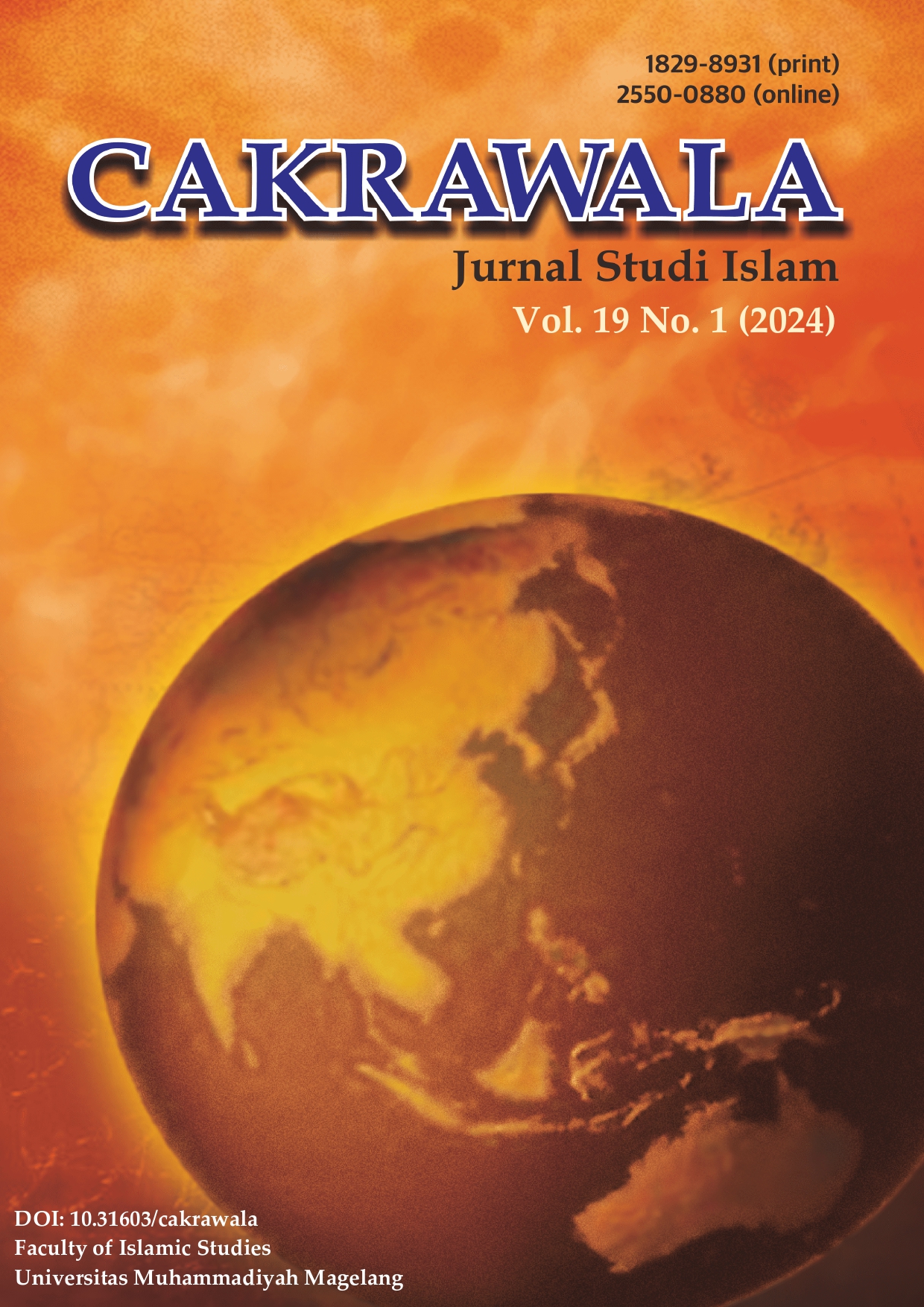Main Article Content
Abstract
This study investigates how the existence of religious scholars in the digital era, characterized by the dominance of new media and pop culture, influences people's understanding and practice of religion. Through qualitative research, this study shows that new media has transformed the way people access religious information and interact with religious scholars. While new media offers easier access, it also presents challenges such as the proliferation of inaccurate information and the commercialization of religion. This study highlights the importance of digital religious literacy for the public to be able to critically evaluate information circulating on social media and choose credible religious references.
Keywords
Article Details

This work is licensed under a Creative Commons Attribution-NonCommercial 4.0 International License.
References
- Al-Jabiri, M. A. (2009). Buniyyah Al-‘Aqli Al-‘Arabi: Dirasah Tahliliyah Naqdiyah Linadhmil Ma’rifah fi Al-Saqafah Al-‘Arabiyyah. Bait al-Nahdhah.
- Chairi, E. (2019). Ketiadaan Otoritas Terpusat dalam Fenomena Kontemporer di Indonesia. SANGKéP: Jurnal Kajian Sosial Keagamaan, 2(2), 197–215. https://doi.org/10.20414/sangkep.v2i2.666
- Chaniago, R. H. (2018). Pesona dan Kharisma Ustadz dalam Imaginasi Populer di Indonesia. Journal Communication Spectrum, 8(1), 1–14.
- Clark, L. S. (2012). Religion and Authority in a Remix Culture. Routledge.
- Creswell, J. W., & Poth, C. N. (2013). Qualitative Inquiry and Research Design: Choosing Among Five Approaches. SAGE Publication.
- Damanik, N. (2019). Muhammad Abid Al-Jabiri. Al-Hikmah: Jurnal Theosofi Dan Peradaban Islam, 1(2), 116–145. https://doi.org/10.51900/alhikmah.v1i2.4843
- Dhofier, Z. (2019). Tradisi Pesantren: Studi Pandangan Hidup Kyai dan Visinya mengenai Masa Depan Indonesia (sembilan). LP3ES.
- Durkheim, E. (2001). The Elementary Forms of Religious Life. Oxford University Press.
- Eriyanto. (2022). Metode Netnografi; Pendekatan Kualitatif dalam Memahami Budaya Pengguna Media Sosial. PT. Remaja Rosdakarya.
- Fahma, A. H., & Darwis, M. (2020). Eksistensi Para “Gus” di Instagram: Visual Semiotik Sebagai Dakwah Baru di Era Digital. Dakwatuna: Jurnal Dakwah Dan Komunikasi Islam, 6(2). https://doi.org/10.36835/dakwatuna.v6i2.655
- Geertz, C. (1960). The Javanese Kijaji: The Changing Role of a Cultural Broker. Comparative Studies in Society and History, 2(2), 228–249.
- Gunawan, M. S. (2020). Retorika Dakwah K.H Ahmad Bahauddin Nursalim (Gus Baha) di Masjid Sirotol Mustaqim Ansan Korea Selatan dalam Youtube. IAIN Salatiga.
- Gustman, R. R. (2015). Karakteristik Media Sosial dalam Membentuk Budaya Populer Korean Pop di Kalangan Komunitas Samarinda dan Balikpapan. EJournal Ilmu Komunikasi, 3(2), 224–242.
- Hamerma, H. (1992). Tokoh-tokoh Filsafat Barat Modern. Gramedia.
- Hatina, M. (2010). Ulama, Politics, and the Public Sphere: An Egyptian Perspective. The University of Utah Press.
- Howell, J. D., Fealy, G., & White, S. (2008). Modulations of Active Piety: Professors and Televangelists as Promoters of Indonesian “Sufisme.” In Expressing Islam : Religious Life and Politics in Indonesia. Institute of Southeast Asian Studies.
- Kiptiyah, S. M. (2017). Kyai Selebriti dan Media Baru. Jurnal Masyarakat Dan Budaya, 19(3). https://doi.org/10.14203/jmb.v19i3.495
- Kustiawan, W., Multazam, D. I., & Restilia, T. (2023). Media dalam Pendekatan Pemikiran Postmodern atau Dekonstruksi. Jurnal Ilmiah Wahana Pendidikan, 9(2), 297–306.
- Lane, R. J. (2008). Jean Baudrillard: Routledge Critical Thinkers Essential Guides for Literary Studies. Routledge Taylor & Francis Group.
- Lauer, R. H. (1993). Perspektif dalam Perubahan Sosial. Rineka Cipta.
- Masyitoh, R. (2023). Dakwah Melalui Media Sosial (Studi Dakwah Gus Iqdam pada Majelis Ta’lim Sabilu Taubah). Mukammil: Jurnal Kajian Keislaman, VI, 1–17.
- Moleong, L. J. (2006). Metode Penelitian Kualitatif (I. Taufik (ed.); 22nd ed.). PT. Remaja Rosdakarya.
- Munib, A. (2020). Framing Media Atas Pemberitaan Sertifikasi Dai. Jurnal Peurawi: Media Kajian Komunikasi Islam, 3(2).
- Nandiastuti, S. (2020). Retorika Dakwah Gus Miftah Melalui YouTube. IAIN Purwokerto.
- Nisa, E. F. (2018). Creative and Lucrative Daʿwa: The Visual Culture of Instagram amongst Female Muslim Youth in Indonesia. Asiascape: Digital Asia, 5(1–2), 68–99. https://doi.org/10.1163/22142312-12340085
- Piliang, Y. . (2011). Bayang- Bayang Tuhan: Agama dan Imajinasi. PT. Mizan Publika.
- Pradani, E. Y. A. (2022). Self Presentation Pendakwah Miftah Maulana Habiburrahman (Gus Miftah) di Akun Instagram @gusmiftah. UIN Prof. K.H. Saifuddin Zuhri Purwokerto.
- Qomar, M. (2002). Pesantren dari Transformasi Metodologi Menuju Demokratisasi Institusi (S. Mahdi (ed.); 1st ed.). Erlangga.
- Rofiq, M. (2023). Pendekatan Komunikasi Massa dalam Dakwah Gus Iqdam di Majelis Taklim Sabilu Taubah Blitar. JADID: Journal of Quranic Studies and Islamic Communication, 3(2), 45–60.
- Strinati, D., & Mukhid, A. (2020). Popular Culture: Pengantar Menuju Teori Budaya Populer. Pustaka Promthea.
- Turmudi, E. (2006). Struggling for the Umma: Changing Leadership Roles of Kyai in Jombang, East Java. the Australia National University Press. http://www.jstor.org/stable/j.ctt2jbk2d
- William, R. (1983). Keywords: A Vocabulary of Culture and Society. Oxford University Press.
- Zulaecha, N. N., Hafidz, Pertiwi, B. N. O., & Nashihin, H. (2023). Pemanfaatan Media Sosial sebagai Dakwah Digital dalam Penyiaran Kalangan Kaum Milenial di Instagram (Ustad Hanan Attaki). Attractive : Innovative Education Journal, 5(2).

